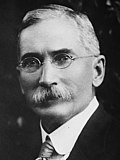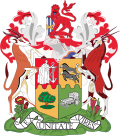| No. | Portrait | Name
(Birth–Death)
Constituency | Term of office | Elected
(Parliament) | Political party | Government |
|---|
| Took office | Left office | Time in office |
|---|
| 1 |  | Louis Botha
(1862–1919)
MP for Standerton, Transvaal Province
(until 1915)
MP for Losberg, Transvaal Province
(from 1915) | 31 May 1910 | 27 August 1919 | 9 years, 88 days | 1910 (1st)
1915 (2nd) | South African Party | L. Botha I–II |
|---|
| First South African Prime Minister. Formation of the Union of South Africa. World War I. Conquest of the German South West Africa. Crushed the Maritz rebellion. Ratified the Treaty of Versailles. Died in office. |
| 2 |  | Jan Christiaan Smuts
(1870–1950)
MP for Pretoria West, Transvaal Province | 3 September 1919 | 30 June 1924 | 4 years, 301 days | — (2nd)
1920 (3rd)
1921 (4th) | South African Party | Smuts I–II |
|---|
| Attended 1921 Imperial Conference. Attempted to broker an armistice and peace deal between the British and Irish nationalists in the Irish War of Independence. Crushed the Rand Rebellion, which caused a political backlash and he lost 1924 general election to National Party. Created coalition with National Party and returned as Deputy Prime Minister and Minister of Justice after the 1933 general election. |
|  | James Barry Munnik Hertzog
(1866–1942)
MP for Smithfield, Orange Free State Province | 30 June 1924 | 5 September 1939 | 15 years, 67 days | 1924 (5th)
1929 (6th)
1933 (7th)
1938 (8th) | National Party
(until 1934)
United Party
(from 1934) | Hertzog I–II–III–IV |
|---|
| 3 |
|---|
| Replaced Dutch as second official language by Afrikaans in 1925. Instated a new national flag in 1928. Approved women's suffrage for white women with the Women's Enfranchisement Act, 1930. Adoption of the Statute of Westminster 1931. Removed Black voters from the common voters roll. Created coalition with South African Party to form the United Party. Resigned after the United Party caucus refused to accept his stance of neutrality in World War II. |
|
|---|
| (2) |  | Jan Christiaan Smuts
(1870–1950)
MP for Standerton, Transvaal Province | 5 September 1939 | 4 June 1948 | 8 years, 273 days | — (8th)
1943 (9th) | United Party | Smuts III |
|---|
| World War II. Ratified the UN Charter. Issued the Fagan Report, which stated that complete racial segregation in South Africa was not practical and that restrictions on African migration into urban areas should be abolished. Lost the 1948 general election to National Party. |
| 4 |  | Daniël François Malan
(1874–1959)
MP for Piketberg, Cape Province | 4 June 1948 | 30 November 1954 | 6 years, 179 days | 1948 (10th)
1953 (11th) | National Party | Malan I–II |
|---|
| Came to power on the program of apartheid and began the comprehensive implementation of the segregationist policy. |
| 5 |  | Johannes Gerhardus Strijdom
(1893–1958)
MP for Waterberg, Transvaal Province | 30 November 1954 | 24 August 1958 | 3 years, 267 days | — (11th)
1958 (12th) | National Party | Strydom |
|---|
| Tried to cut ties with United Kingdom. Removal of Coloured voters from the common voters roll. Extended 'treason trial' of 156 activists (including Nelson Mandela) involved in the Freedom Charter. Severed diplomatic relations with the Soviet Union. Died in office. |
| 6 |  | Hendrik Frensch Verwoerd
(1901–1966)
MP for Heidelberg, Transvaal Province | 2 September 1958 | 6 September 1966 | 8 years, 4 days | — (12th)
1961 (13th)
1966 (14th) | National Party | Verwoerd I–II |
|---|
| Start of the South African Border War. The Wind of Change speech by British PM Harold Macmillan. Proclaimed South Africa a Republic outside the Commonwealth of Nations on 31 May 1961 after the 1960 referendum. Abolished the separate Black voters roll. Launched the bantustan programme. Assassinated. |
| 7 |  | Balthazar Johannes Vorster
(1915–1983)
MP for Nigel, Transvaal Province | 13 September 1966 | 2 October 1978 | 12 years, 19 days | — (14th)
1970 (15th)
1974 (16th)
1977 (17th) | National Party | Vorster I–II–III |
|---|
| Abolished the Coloured voters roll. South African Border War escalated into a full-scale conflict. He managed policy of détente with African countries, and accepted to let black African diplomats living in white areas. He alienated an extremist faction of his National Party when it accepted the presence of Māori players and spectators during the 1970 New Zealand rugby union tour of South Africa. He unofficially supported, but refused to recognize officially, the neighbouring state of Rhodesia, which was ruled by a white minority government that had unilaterally declared independence from United Kingdom. In 1974, under pressure from US Secretary of State Henry Kissinger he pressured Ian Smith, the Prime Minister of Rhodesia, to accept in principle that white minority rule could not continue indefinitely. Resigned. |
| 8 |  | Pieter Willem Botha
(1916–2006)
MP for George, Cape Province | 9 October 1978 | 14 September 1984 | 5 years, 341 days | — (17th)
1981 (18th)
1984 (19th) | National Party | P. W. Botha |
|---|
| Remained Minister of Defence until 1980. Improved relations with the West. Authorized radical constitutional reform in 1983, including the creation of the Tricameral Parliament, which give a limited political voice to the country's Coloured and Indian population groups. The majority Black population group was still excluded. Began a secret nuclear weapons program in collaboration with Israel, which culminated in the production of six nuclear bombs. Creation of police counter-insurgency unit, Koevoet. Resignation of Vorster as State President in the wake of the Muldergate Scandal. Abolished the position of Prime Minister in 1984 and became executive State President. |











